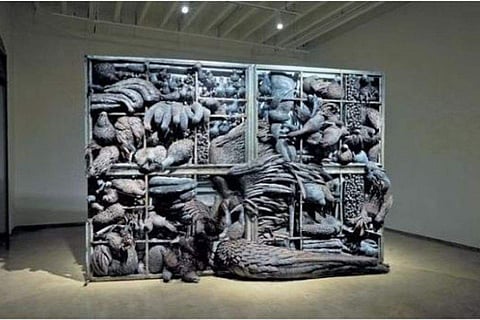
- LIFESTYLE
- FASHION
- FOOD
- ENTERTAINMENT
- EVENTS
- CULTURE
- VIDEOS
- WEB STORIES
- GALLERIES
- GADGETS
- CAR & BIKE
- SOCIETY
- TRAVEL
- NORTH EAST
- INDULGE CONNECT

At first glance, the subject of contemporary sculptor Sakshi Gupta’s ongoing show—If the Seas Catch Fire—at Mumbai’s Experimenter gallery, appears to be the ecological crisis. One walks into the space—the low light stripping the walls off their white—and sees sculptures of birds of different kinds. There’s also some flora, all made out of metal scrap. It seems, through the works, she’s commenting on how the planet is turning into a concrete jungle.
But, that is the beauty of art—interpretation is personal business. The environment was not on Gupta’s mind when she was making the six works that are part of the show. She was thinking about a crisis all right, but of the existential kind. “Since my teenage years, I have been curious about us as human beings and the world we live in.
I have wanted to understand the point behind all of this—why are we here? Sometimes it almost seems essential that we exist, but sometimes it doesn’t make sense at all,” says the 44-year-old artist, adding, “With time and age, these questions take different shapes and forms, and varied aspects are revealed of the same inquiry. I feel the need to channelise it through my art.”
The universally shared mental chaos is rendered a poignant form in the central work, ‘Spaces of Being’. The 7x10 feet work recreates the unsettling image of a packed-over-capacity chicken coop, where birds of all kinds and sizes are stuffed into the quarters. “It talks about the frustrations in one’s mind, where thoughts clash with one another. We try to compartmentalise, but that seems difficult with an overthinking mind, quite similar to the birds in a chicken coop. They are dying, fighting birthing... everything is happening together,” Gupta elaborates.
The four-panelled work is made entirely out of metal scrap. Material is Gupta’s metaphor. Through her decade-long practice, she has also used concrete, sometimes stoneware and other mediums that demonstrate the idea of circularity: what was someone’s past, can be another’s future. The metal that once existed perhaps as a car or an almirah transforms into a work of art. Admitting that she has even picked up objects from the road or outside her studio in Mumbai, she says, “If you consider the city as an organism, it is going through constant upheaval. I am interested in things that are being thrown out, or those that are simply lying around.”
It is the humanness of animals, and the animalness of humans that forms the essence of Gupta’s show. In ‘To Keep Things Whole’, she places six life-like sculptures of the ubiquitous pigeon in the corners of the three-roomed gallery space and its corridors. But, it is Gupta’s nuanced allegorisation that strikes a chord. She says, “Humans are like pigeons. The bird keeps hitting itself against the same glass window. It must obviously be in pain, but it doesn’t learn. It’s a bit like what we do to ourselves. Humans too refuse to learn from their mistakes.”
Capturing the thought is another work titled, ‘For Beauty is Nothing but the Beginning of Terror, That We are Still Able to Bear’. Featuring multiple gunny sacks (created in stoneware) with animal hooves protruding out, the installation is unnerving. “It is about how we feel trapped in our own patterns of thought. And then the struggle to break out starts,” she says, adding, “Even though we have a language to communicate, we find it difficult to express ourselves.”
That is why Gupta turned to poetry for the title of the show. She borrows it from a line in EE Cummings’s poem, Dive for Dreams. The American poet recommended making love the anchor in the likelihood of an unimaginable catastrophe when he wrote, “Trust your heart if the seas catch fire”. Gupta, while agreeing with Cummings, adds another layer to his words. She says, “Human beings are 70 per cent water; in that sense, we too are carrying a sea within ourselves—a sea of thoughts, of feelings. And when we experience frustration or rage, we are, in a way, set on fire. But, there exists a possibility of coming out; it is almost like an essential passage that we must walk to come to the other side. We can’t think of evolving without our experiences.”